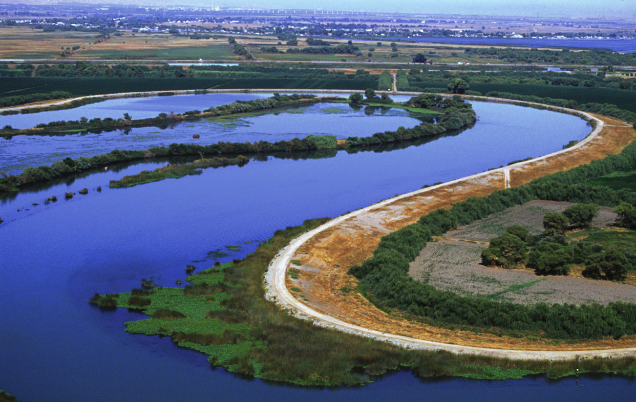
California Bay Delta water (Photo: USGS.gov)
Water Supply Disaster Looming for the San Joaquin Valley and Southern California
Disputes over exporting Delta water supplies looks like unsound science verses the needs of all Californians.
By Don Wright, August 28, 2024 7:03 am
There is a water supply disaster looming for the San Joaquin Valley and Southern California on the near horizon. It’s come about as part political indifference and political theater; part bureaucratic inertia and irascible imperviousness by appointed officials. At stake is the water contracted by the federal Central Valley Project and the State Water Project not being delivered as part of an action nominally meant to help, but not actually helping, the endangered Delta smelt.
Two letters, one from water contractors and another from water policy conservation groups have been sent appealing the proposed Fall X2 regulations. A letter to Department of Water Resources Director Karla Nemeth and US Bureau of Reclamation Regional Director Karl Stock was signed by the Friant Water Authority, San Luis Delta Mendota Water Authority, State Water Contractors and Westlands Water District.
Another letter signed by the Water Blueprint for the San Joaquin Valley and the Southern California Water Coalition was sent to Governor Gavin Newsom and Secretary of Interior Debra Haaland. So, the leading state and federal agency department heads, the highest elected official in California and a federal Cabinet level Secretary have been informed of the problem.
The government agencies tasked with making a decision about the Fall X2 line have the legal authority to implement sound science with little to no drawdown of staff time and resources.
The X2 Line
California’s Delta, where the Sacramento River from the north and the San Joaquin River from the south, flow to the low area and converge to create a series of channels and islands before draining through the Carquinez Straight, under the Golden Gate Bridge and into the Pacific Ocean. Because this area is low, tidal forces will move salt water upstream past Suisan Bay and into the Delta. Before dams the Delta would flood with salt water during the summer and during droughts. The winter rains and spring snowmelt would flush the Delta.
By some estimates more than half of the Delta’s habitat has been lost to development. The inclusion of levees and upstream dams have disrupted this brackish/freshwater cycle. Commercial and residential areas in the Delta, the Bay Area and Sacramento as well as agriculture all depend on freshwater. Agriculture, of course, needs freshwater for plants and livestock. The metropolitan areas of the San Francisco Bay Estuary need freshwater for human habitation and to dilute their waste discharges to meet regulatory thresholds. The natural intrusion of brackish water into the Delta would place millions of people’s water supply in jeopardy.
What is known as the X2 line, was established to help prevent harm to the human and Delta habitat needs. X2 is the distance from the Golden Gate, upstream to where the bottom of the outflowing Delta waters measures two parts per thousand of salt. In comparison ocean water is 35 parts per thousand. The stronger the tidal forces and the lower the amount of freshwater outflow from the Delta, the greater the distance of the X2 line.
Moving Water
Located in the southwest portion of the Delta near the City of Tracy are two pumping plants. There is the federal C.W. Bill Jones Pumping Plant owned and operated by the US Bureau of Reclamation. This is an integral part of the federal Central Valley Project which extends from Lake Shasta to south of Bakersfield. The Jones Plant moves water into the Delta Mendota Canal south to water the farmland in the fertile San Joaquin Valley’s westside.
Nearby to Jones is the state’s Harvey O. Banks Pumping Plant. The Banks Plant is a major component of California’s State Water Project which extends from Oroville into Southern California. The Banks Plant moves Delta water into the California Aqueduct that in turn conveys it to the base of the Tehachapi Mountains at the southern end of the San Joaquin Valley. There it is pumped over the mountain range and into the Los Angeles Basin. Pumping this water uphill is the single, largest user of power in the state. The Aqueduct, along with the Colorado River provides freshwater to most of California’s population.
The Problem
Since two/thirds of California’s precipitation falls north of the Delta and two/thirds of the water use is south, Delta pumping is vital to most of California. It is vulnerable and can be greatly disrupted by regulations imposed by the government based on the location of the X2 line. Specifically, the Fall X2 line. There is a complex regulatory framework covering the operations of the Delta’s water flows involving when and how much pumping can take place and how much water must be released from upstream dams.
Under the lead of the US Bureau of Reclamation and the Department of Water Resources the California and federal Fish & Wildlife Agencies and the federal National Marine Fisheries Service are preparing a new regulatory scheme for long-term operations of the Delta. This update hasn’t taken place for years before the Trump Administration. Operations were based on a calendar. Literally predetermined dates set Delta pumping levels. The calendar based criteria wasn’t producing results that helped endangered species recovery, the Delta habitat or supply certainty for water users depending on pumping.
The focus of the Fall X2 line is sending hundreds of thousands of acre feet of freshwater through the Delta out to sea in the hopes of helping the endangered Delta smelt; instead of using it to supply the needs of homes and businesses throughout California.
Adaptive management is now possible where fish populations can be monitored and real time conditions can be used to manage operations. Under the old calendar system, the pumps were turned on and off according to dates whether any endangered fish were present or not. The state sued the Trump Administration to prevent adaptive use methodology for long-term operations. When the Biden-Harris Administration took office, the methodology was reverted to that used specifically on the last day of the Obama Administration – the calendar method.
Impacts
The letter by the four water entities sent to Nemeth and Stock states, “For example, in 2023 alone, the water cost to implement the measure was greater than 730,000 acre-feet between the two Projects. This water could have otherwise been kept in storage, delivered for use at farms and in cities, stored or banked for drought resiliency or used for a variety of other purposes, including other environmental purposes like improving water quality or temperature improvements.”
The letter further states, “For the 2024 operational year, Fall X2 is anticipated to reduce the CVP and SWP water supplies by an estimated 350,000 acre-feet, primarily through reduced exports, but also through additional releases from upstream reservoirs. For context, this is equivalent to one-third of Folsom Lake or nearly $200 million worth of water, if purchased on the open market, with untold additive economic value to the State were it able to be used in a different manner.”
The letter to Newsom and Haaland sent by the Water Blueprint and the So Cal Water Coalition states, “California is facing a severe budget deficit, and many thousands of people in disadvantaged communities in the San Joaquin Valley face economic hardship due to an inability to find work on farms — in large part because water-supply reductions have limited planted acreage and associated economic activity.”
Should the government agencies reviewing long-term operations in the Delta opt to continue the proposed calendar based Fall X2 guidelines instead of implementing the adaptive management proposals it will have serious negative impacts on the water supply and economic benefits for all of California. And the incongruity of it all is – sound science doesn’t support the current Fall X2 releases.
The application of the current Fall X2 regulations have been studied since 2008. Findings from studies in peer-reviewed journals are part of a growing body of evidence included in the US Fish & Wildlife’s draft biological opinion. A 2024 study by Leo Polansky, Lara Mitchell and Matthew L. Nobriga published in Conservation Science and Practice stated, “The findings here suggest summer, not fall or winter–spring, is the most important season for freshwater flow augmentation to assist Delta Smelt population growth rate,” it goes on to state, “However, the more important question for the purposes of this effects analysis is whether the PA’s [perturbation analyses] fall flow regime will have negative effects on delta smelt, specifically if variation in fall outflow will result in a detectable change in survival of the affected life stage. The Service has previously concluded that it would (Service 2008; 2019); however, this conclusion is not supported by life cycle analysis.”
Moving Forward
The four water entities’ letter concluded, “. . . we thank you for your consideration of this important matter. We feel that a decision to not implement Fall X2 this year has a clear basis in the observations, science, and processes identified above. In the event of a different decision, being to either fully implement or modify Fall X2, we respectfully request a written justification that includes a scientific basis. Such documentation will provide crucial transparency for this and future science-based decision-making and could highlight areas requiring targeted research to address any remaining areas of disagreement or uncertainty pertaining to Fall X2.”
The letter from the Blueprint and the So Cal Water Coalition ended with “. . . [the two organizations] respectfully requests that the Fall X2 Action be suspended for 2024, concordant with the adaptive management principles that are embedded in the underlying regulatory determinations and documents.”
Dr. Eddie Ocampo, Chair of the Blueprint said, “Implementing this action is projected to cause a loss of between 300,000 to 400,000 acre-feet of water supplies over the next two months that could otherwise be beneficially used. Science over the last decade has demonstrated that this action, which has a significant water supply cost, is not producing the intended benefits for species, but has reduced water supply for impacted communities reliant on the water provided through the Central Valley Project and State Water Project.”
“The ongoing implementation of the Fall X2 Action based on outdated scientific data simply does not make sense, particularly given its detrimental impacts to the economic and environmental well-being of the people of the San Joaquin Valley and Southern California,” said Charley Wilson, executive director of the Southern California Water Coalition. “It is critical that water project operations are governed by an adaptive management approach that reflects current scientific understanding and minimizes unnecessary impacts to our communities.”
The powers that be have been notified of the problems with the current Fall X2 regulations and should be aware of the decisions needed. Disputes over exporting Delta water supplies have often been framed as farmer verses fish. In this case it looks like unsound science verses the needs of all Californians.
The public can comment on the inclusion of Fall X2 in the proposed action of the pending Reinitiating of Consultation on the Long-Term Operations of the CVP and SWP, which had its Draft Environmental Impact Statement released on July 26th with comments due Sept 9th.
If you’d like to make your opinion known you can comment at dwrwebcomment@water.ca.gov or to reach the USBR click here.
- Jottings: California State Assembly Water, Parks & Wildlife Committee 4/29/2025 - April 30, 2025
- State Water Board’s Reckless Handing of the Sustainable Groundwater Management Act - March 4, 2025
- State Water Board Held Hearing Concerning Placing Kern Subbasin Under Probation, Part I - February 25, 2025





From the beginning, those of us without “water expertise” have suspiciously watched this issue and wondered what the heck is actually going on here. The preposterous “saving the Delta smelt” argument was debunked (it seems to me) almost two decades ago. $30 billion in water bonds voted in by Californians since 2000 that were meant to build and expand water infrastructure have been ignored and the money diverted to token and idiotic “green” projects by our state and local “leadership.” The decisions of the bureaucrats and politicians in charge have been almost comically absurd over the years (e.g., the Delta smelt “drama,” the release of obscene amounts of fresh water to the ocean).
We’ve watched as water delivery to farmers and ranchers has decreased, year by year, to a near-trickle of former necessary levels. We’ve watched farmers and ranchers (and urban residents) adapt and adapt and conserve and conserve, until conservation efforts, inevitably, reached an end and were no longer feasible. We’ve seen vast amounts of farmland fallowed, groundwater pumped to the point that the ground sank, water rights for property owners taken away, etc. The list of absurdities and contradictions goes on and on.
The layperson cannot help but notice that all of what has been ordered by leadership and bureaucrats over the years has killed farms and farmers and ranchers and unnecessarily restricted urban water users.
What is behind it and why? What is the end game here? It would be helpful if someone with the necessary “expertise” and gravitas in this matter would simply state outright what they believe is the impetus and the goal behind this puzzling, unnecessary, and decades-long destruction to the state’s agriculture and the endless and ridiculous restrictions on its urban residents.
Thanks for the X2 line information. I have not heard of it before even in Agricultural publications. Is the end game to get rid of more conservative voting farmers by taking away their water?
That does appear to be one big reason behind what we have been seeing for so many years.
Water Supply Disaster Looming for the San Joaquin Valley and Southern California – California Globe
A good summary of the absurdity of Federal/State water management…driven by disproven environmental actions/mantras. X2 is reality….this week! 300,000 to 400,000 acre feet of water to be unnecessarily (and without benefit) wasted to the Pacific….yet the bureaucrats’ arrogance prevails! When with the State’s “sheeple” wake up? Jobs? The economy of the Valley? Food prices? Nothing short of criminal….